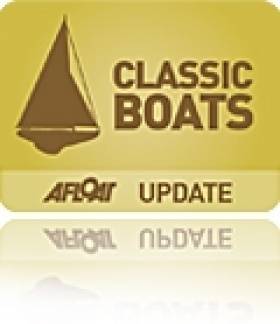Displaying items by tag: Huff of Arklow
#dlregatta – Anyone who thinks they're comprehending all the action and the full story in the continuing, colour-filled and action-packed sailfest in Dublin Bay clearly hasn't been there. You can only grasp quick visual and mental snapshots of specific classes and the sport in their racing areas, and then not only is what you're observing changing by the minute – or more accurately by the second – but something else intervenes, some other completely different boat class or incident swings into view, and you have to adjust your mind-set in jig time.
The final results of each race may put some meaning on it all. But for devotees of the unique Dublin Bay sailing scene, the results are only the tip of the iceberg. W M Nixon tells us he wouldn't presume to try to makes sense of it all, so this is just a personal take on a mega-event.
The laws of Camelot seem to prevail in Dublin Bay during these precious, priceless few days. You'll remember that in Camelot the rain is only permitted to fall at night. Well, the Camelot Code has been adhered to so far. And while there is undoubtedly rain expected from the west later today, with any luck the racing will have been completed, any heavy precipitation will pass harmlessly through during darkness, and tomorrow's final morning of racing will be sailed in that special crystal clear sunlit air which follows a damp Irish night.
We can only hope so. At the moment, as Evelyn Cusack so helpfully told us on Thursday night on RTE1 Weather, the Jetstream is swirling along vigorously, and it's close to the southward off the south coast of Ireland, creating distinctly unstable conditions.
But while the weather has been grim out west, we've seen the East Coast effect working well. You may think Wexford is Ireland's sunniest county, and so it is. But the Dublin area is the driest. Rain coming across Ireland is losing its strength as it approaches Kildare, and by the time the cloud reaches the lower Liffey Valley, that's all it is – cloud.
However, other factors are in play at this time of year, and with a bit of sunshine southerly breezes can become southeasterly sea breezes of considerable power. But the lawmakers of Camelot were so busy keeping the rain in order that they overlooked wind strengths altogether. So for the first two days, conditions have been a little brisker than some would have wished, and yesterday saw postponement for the smaller boats, but the cruiser classes were expected to slug it out as usual.
It was all a bit too much of everything, and further to complicate thing, I found myself on the opening day racing aboard a boat for which, for once, the word "iconic" is the only one that will do.
We've been following the story of Huff of Arklow and her restoration here on Afloat.ie for quite some time now. But as ever, the old Chinese saying that seeing something once is worth hearing about it a hundred times was proven abundantly true when Huff came sailing out of Belfast docks amidst the tall Ships on Sunday. Here indeed was the unique and authentic Uffa Fox design, as built by Jack Tyrrell and his craftsmen in Arklow in 1951.
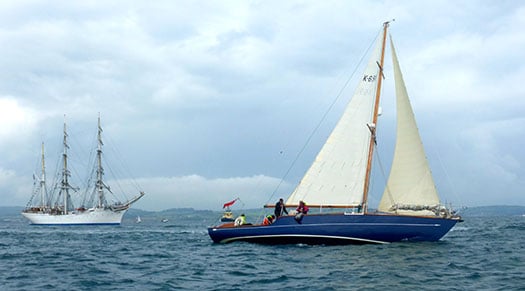
The real deal. Huff of Arklow with the Norwegian Tall Ship Statsraad Lehmkuhl on Belfast Lough last Sunday. Photo: W M Nixon
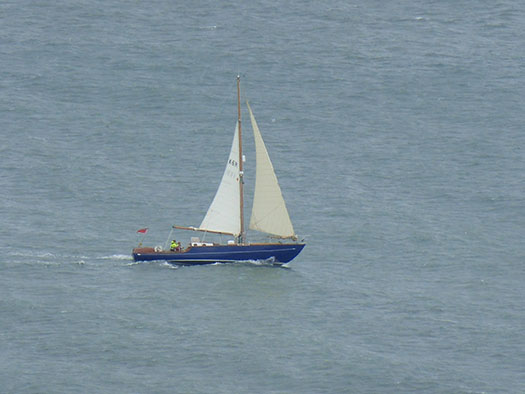
Doing what she does best. Huff of Arklow returns to Dublin Bay, as seen from the Baily at lunchtime Wednesday, after a record reaching passage from Ardglass Photo: W M Nixon
Describing her as authentic is the key to it. Since leaving Dublin Bay around 1970, Huff had undergone previous restorations, and had also survived an arson attack which miraculously left her hull intact but led to a further restoration which somehow lost the character of the boat even more.
But then in 2001 she started on the road back to a genuine restoration by being taken on by Uffa Fox enthusiast Andrew Thornhill of Bristol, who in turn saw to it that she was taken under the wing of a new classic yacht organization called Cremyll Keel Boats run by Dominic and Barbara Bridgman, and operating out of the old Mashford's boatyard at Cremyll on Plymouth Harbour.
They've re-created the flavour of Huff, they've re-captured her spirit, and in making their Dublin Bay debut at the Royal St George YC in the Volvo Dun Laoghaire Regatta 2015, they've paid their proper respects to the remarkable Douglas Heard.
In addition to being the founding President of the Irish Dinghy Racing Association in 1946, he was Commodore Royal St George YC 1960-1965, where his five innovative years in the top job were also his busy final five years with the Huff of Arklow, which he cruised and raced very extensively, with Iceland, the Azores and Portugal being visited by the distinctive dark blue boat from Ireland.
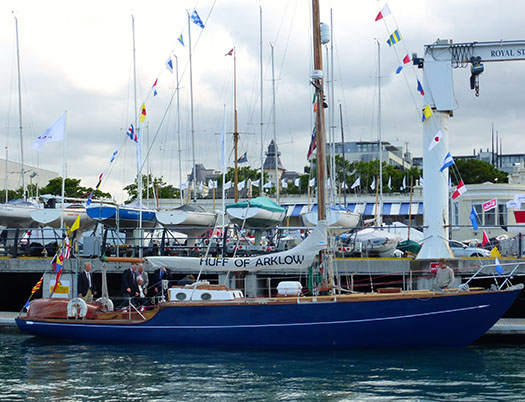 Home again – Huff of Arklow at the Royal St George YC, where she was the Commodore's yacht from 1960 to 1965. Photo: W M Nixon
Home again – Huff of Arklow at the Royal St George YC, where she was the Commodore's yacht from 1960 to 1965. Photo: W M Nixon
"Distinctive" is scarcely adequate. You'll never see anything like Huff. Basically, she's a double-size Flying Fifteen with a raised foredeck which comes well aft of amidships in order to provide impressive accommodation, and yet the low racing-style freeboard of a Flying Fifteen was retained down aft to give the new boat a very unusual appearance when she emerged from Tyrrell's yard in the spring of 1951.
But then they were used to "Mr Heard's new boat" being unusual down in Arklow, for in line with Uffa Fox's requirements, she was built with the hull upside-down in double diagonal planking. And among those who were there for Huff's welcome reception from Commodore Justin McKennna and the Royal St George members on Wednesday was Billy Murray of Arklow, who'd worked on the boat as a young trainee shipwright all those 64 years ago, and he remembered clearly that the lower freeboard aft was to help the owner get aboard the boat at moorings.
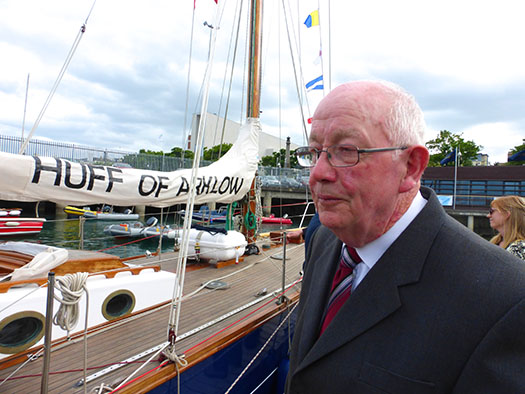
Billy Murray of Arklow, who worked on the building of Huff in the winter of 1950-51. Photo: W M Nixon
For Douglas Heard had been a wounded veteran (and a pensioner) of World War I since the age of 18, and was severely disabled in one leg. But he never let it impair his lifestyle, his zest in new things, his joy in sailing the sea, and his deep interest in boats. This was so total that he extended his seasons afloat with additional active involvement with the inland waterways.
As to how Huff performed, oddly enough she was better at cruising than racing, as she had this roomy accommodation which is very comfortable at sea, and with sheets eased she can go like a train – she arrived into Dun Laoghaire on Wednesday afternoon after a storming reach in a strong nor'wester from Ardglass in less than nine hours.
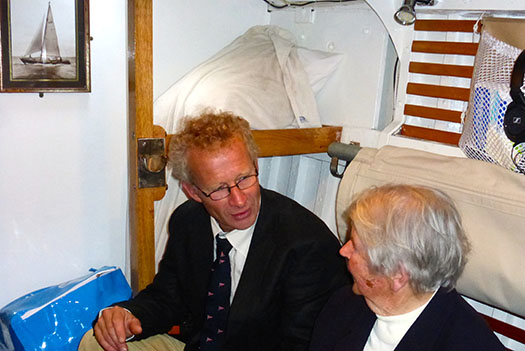
Aboard again. Ruth Heard, who sailed with her late husband Douglas on Huff of Arklow to the Azores, in the saloon with Dominic Bridgman Photo: W M Nixon
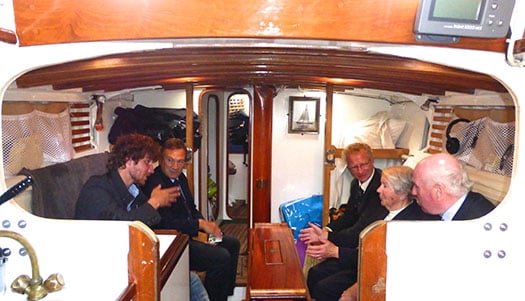
For a boat of her type, Huff of Arklow has remarkably roomy accommodation. Photo: W M Nixon
But for racing in Dublin Bay in her prime, her relatively small area of sail and her quite extensive wetted area meant that she could be sluggish in light airs, she was not at all happy to windward in a sea lumpier than the wind strength merited, and her lack of sharpness on a beat could leave her with a lot of work to do once sheets were eased.
So ideally what we would have needed on Thursday was a nice coastal course with lots of reaching. But of course, what we got was two rounds of a windward-leeward slugging match out on the middle of the bay, and the long old blue lady not at all enjoying tacking duels, and being embarrassed by having many smaller boats snapping around her heels.
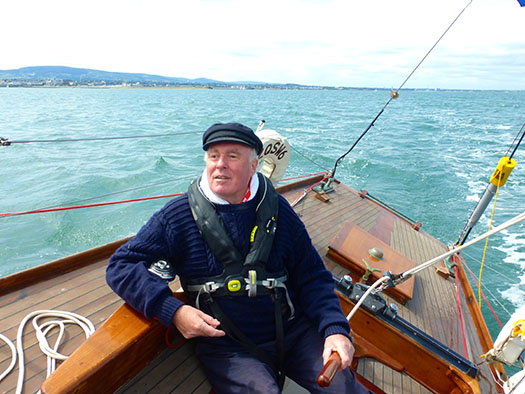
A dream comes true. Uffa Fox enthusiast Andrew Thornhill at the helm of Huff of Arklow, restored and returned to Dublin Bay after 45 years. Photo: W M Nixon
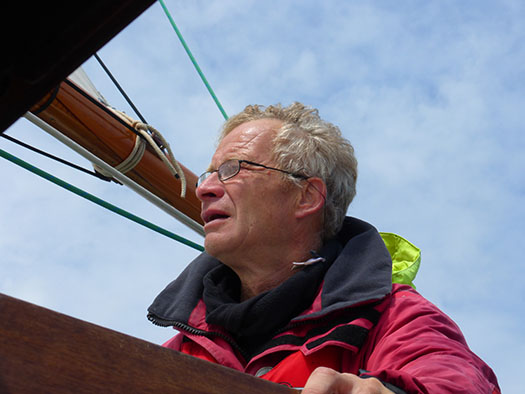 Will we clear them....? With Huff of Arklow charging along on port tack towards a gaggle of smaller more manoeuvrable boats on starboard, Dominic Bridgman has to make the call...... Photo: W M Nixon
Will we clear them....? With Huff of Arklow charging along on port tack towards a gaggle of smaller more manoeuvrable boats on starboard, Dominic Bridgman has to make the call...... Photo: W M Nixon
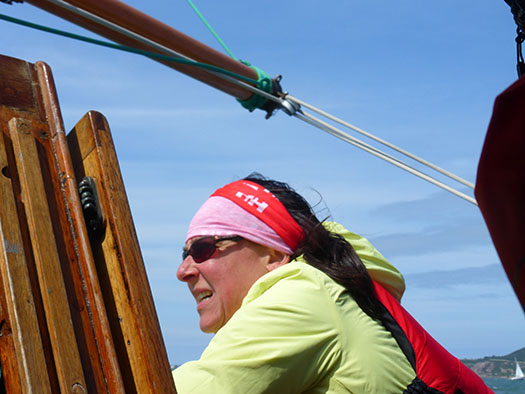 ......and he has his wife Barbara to help him get it right. Photo: W M Nixon
......and he has his wife Barbara to help him get it right. Photo: W M Nixon
Then things settled down a bit and we'd rather a good race with John Raughter's cheekily-named Fulmar 32 Chase Me from Bray SC. But this wasn't in the script at all. Chase Me wasn't even in our class. She was the next class down. However, despite there being 29 different classes in the Volvo Dun Laoghaire Regatta 2015, there wasn't a division for classics, as there doesn't seem to be a significant demand for this in Dublin Bay. And anyway, they'd need their own racing area exclusively for themselves, as many of them have highly individual handling characteristics.
So on a day when Quarter Tonners were dropping masts and our old girl with her veteran sails was at no stage being provided with her favourite point of sailing, we had to take our sport where were could find it. And if it was eventually with Cruiser Class 4 rather than our allocated Cruiser Class 3, so be it. Like the whaling skipper who went right round the world without so much as sighting a whale, let alone catching one, we had a helluva fine sail. And believe me, when Huff of Arklow came to the weather mark for the first time on this her first race in Dublin Bay in 45 years, there was pause for thought. But the old boat just tramped steadily on – she's seen it all before.
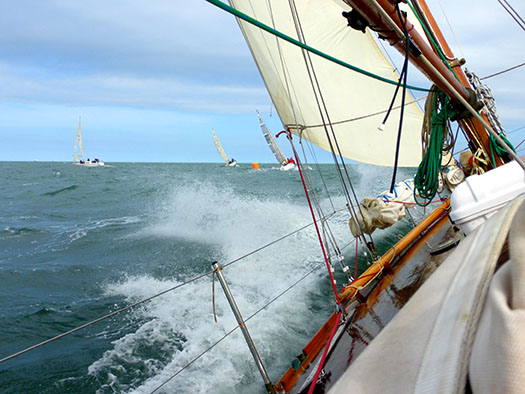 Quite a moment. Huff of Arklow comes to the weather mark in a Dublin Bay race for the first time in 45 years. Photo: W M Nixon
Quite a moment. Huff of Arklow comes to the weather mark in a Dublin Bay race for the first time in 45 years. Photo: W M Nixon
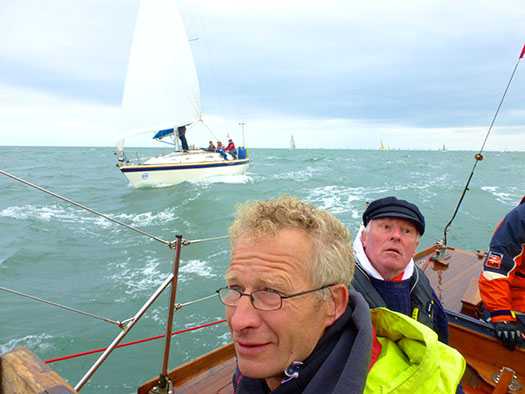 Not quite according to the script. We ended up having good sport with the Fulmar 32 Chase Me from Bray, even if she was in another class. Photo: W M Nixon
Not quite according to the script. We ended up having good sport with the Fulmar 32 Chase Me from Bray, even if she was in another class. Photo: W M Nixon
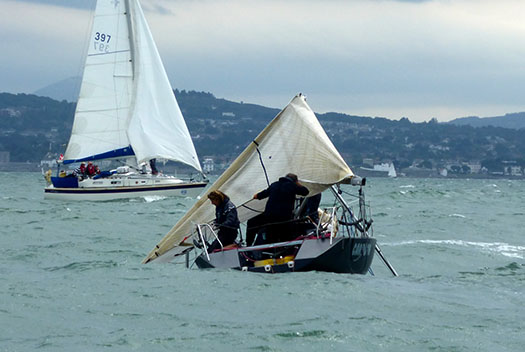 You win some, you lose some, you drop some....... On a day when Quarter Tonners were dumping their sticks, it was good to keep a 64-year-old boat in one piece and still racing. Photo: W M Nixon
You win some, you lose some, you drop some....... On a day when Quarter Tonners were dumping their sticks, it was good to keep a 64-year-old boat in one piece and still racing. Photo: W M Nixon
Thanks to our finish being out in the middle of the bay, your columnist had the opportunity to steer Huff hard on the wind back to Dun Laoghaire Harbour. With her long slim hull and separate skeg-hung rudder, you get the impression she wouldn't turn round out of control to look at you in the manner of modern high-volume boats. But she's remarkably sensitive to fine tuning to take the weight off the helm. In order to make the harbour mouth without tacking, I asked Dominic for an extra little grind on the jib sheet, and Huff immediately responded by showing a slight hint of lee helm. But a tiny bit of haul on the mainsheet, and she was back on virtually neutral helm, with just the essential though barely perceptible weather helm required for a thoroughbred.
With a bit of help from the first of the new ebb, we made it through the harbor mouth without tacking, which provided leisure to savour the scene. You never get tired of sailing into Dun Laoghaire Harbour, and when the Volvo Dun Laoghaire Regatta is in full swing at the end of a day's racing, it's like a continuously-changing living boat show with craft of every size and shape going hither and yon, while zooming through them the foiling Moths were having themselves a tremendous time on an in-harbour course.
We came into the Berth of Honour on the pontoons at the Royal St George, and the club's Rear Commodore Sailing, Frank O'Beirne, came down to see if all was well while our ship's company seemed to find themselves talking to just about everyone on the many boats coming in close past our berth, yet somehow they also got on with the sacred task of Milling the Prosecco. It didn't take too long to decide that Huff of Arklow had just won the Flying Thirty Worlds 2015.
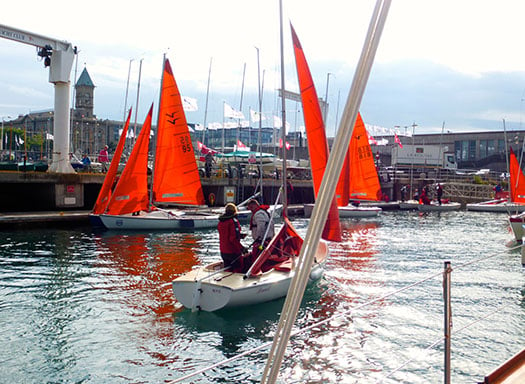
Banter time. By the time the Squbs were coming in after their race to glide close past Huff of Arklow in her Berth of Honour at the Royal St George, it had been discovered we'd just won the Flying Thirty Worlds 2015. Photo: W M Nixon
#huffofarklow – The restoration of the classic yacht 'Huff of Arklow' is nearing completion in Cornwall and anticipating is building to see the 1951 John Tyrrell & Sons builkd back on the water in her original form next month.
The unique yacht designed by the famous Uffa Fox was built for Douglas Heard, a well-known Dublin yachtsman and the first president of the Irish Yachting Association, now Irish Sailing Association. Huff of Arklow was completely unique upon her construction and is believed to be the only example of a Flying Thirty left. She is an irreplaceable boat and has had a revolutionary effect on the history of yacht design. For these, as well as for many other reasons, she is worthy of preservation.
The objective of this restoration is to put Huff back into her original condition as far as possible. She has been underused in recent years causing a build up of moisture due to lack of airing and this encourages mould and corrosion. Her sailing performance has appeared to deteriorate over the last few seasons and perhaps we have never known her at her best simply because she is too heavy and too low in the water.
Huff is now owned by Eyemouth ISCA (International Sail Craft Association). Eyemouth ISCA is an educational charity and it has tied in the restoration project of Huff of Arklow to an NVQ2 apprenticeship in boat building. Two young men have passed a lengthy selection in order to achieve this placement based at Mashfords Boatyard, Cremyll, where Huff lays. The Falmouth Marine School provides the technical side of the course whilst the practical side will focus on the restoration of the Huff.
Huff of Arklow launch party will take place on 7th September!
A lively facebook page detials the restoration here



























